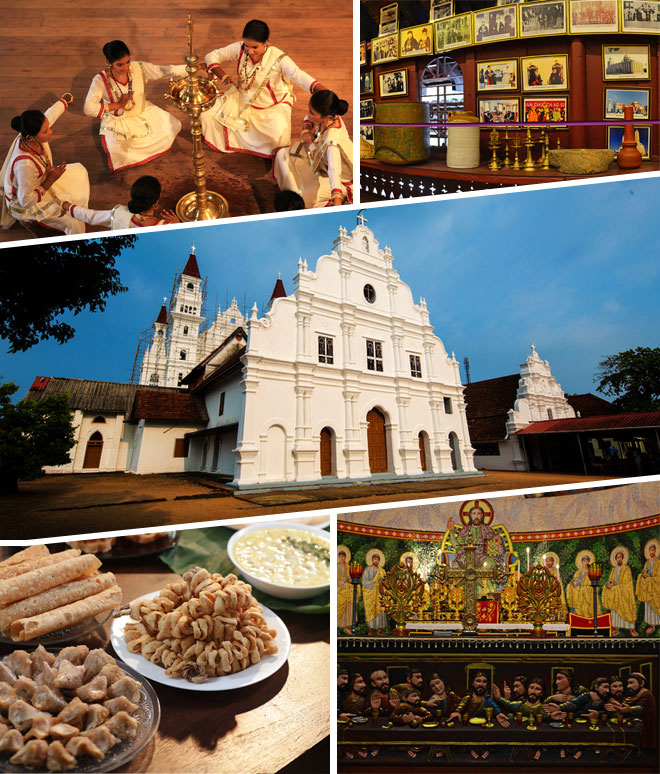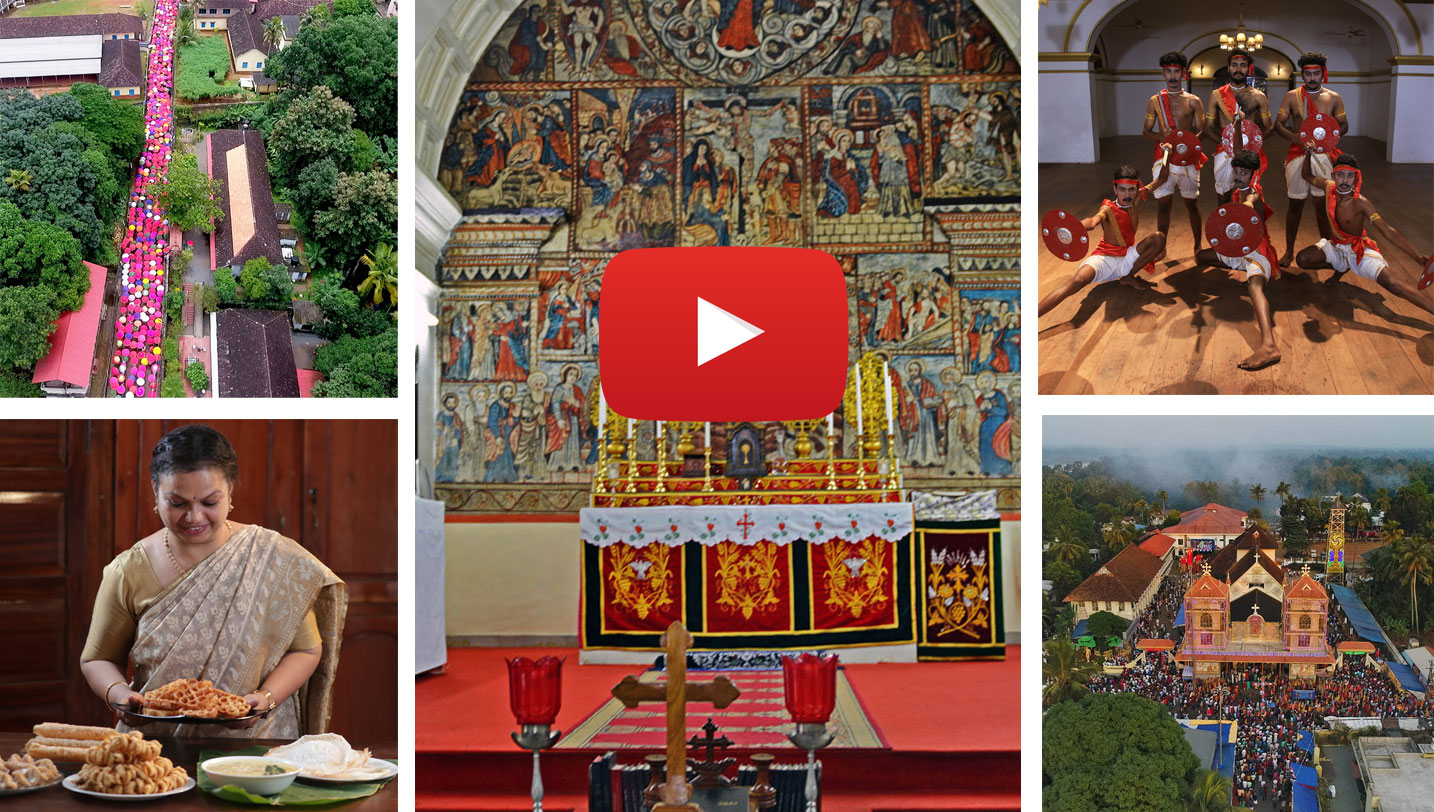Mural Paintings
_large.jpg)
Murals on the western walls of St. George Church, Paliekkara
The murals of Paliekkara (Tiruvalla):
The murals seen on the western walls of the St. George Church at Paliekkara, established in 1815, have a unique style. They depict severally, the birth of Christ, the visit of the Magi from the East, gifts brought by them, Baptism in the Jordan, St. Thomas and Christ, and the twelve disciples, in dark colours with a prominence for glowing blue colour. Syriac inscriptions could be seen under the pictures. Greater importance is given to the decorations than to the lines. The paintings depicted in rustic style on the walls of the Madbaha of the Cheppad Church, established 453 years ago, resemble Persian murals. Though the pictures are claimed to be 400 years old, their originality was lost by its reproduction. All of them have biblical themes. Paintings in some churches show Virgin Mary’s coronation as the queen of heaven. God the Father is shown as bearing the sceptre and Christ bearing the cross. Both are seen to be holding the crown for the coronation together. European paintings, unlike those of Kerala, do not depict Christ as bearing a huge cross.
The images of devotion (Bhakti) and fear:
The murals of Kerala, first seen in churches, are at least four centuries old. No serious study has been conducted about the murals created between 14th and 18th centuries, which come under the category, ‘the Nasrani School of murals.’ Hence, they did not come to public notice. Mural paintings can be seen along with carved pictures, statues, stone crosses and baptismal fonts, in Cheppad, Kanjoor, Paravur, Akaparambu, Angamaly, Ollur, Kadamattom, Kottayam, Piiravom, Kudamaloor, Pazhanji, Mulanturuthy, Chungam, Chathannoor, Paliekkara, Malayattoor, Kottapady, Mannanam, Thevalakkara and Pazhuvil churches.
The Christian school of painting:
When Da Vinci, Michael Angelo and Raphael were engaged in painting in Europe in the 16th century, Kerala churches already had multicoloured murals on the same themes. Moreover, many of them were on a par with the products of Mughal and Rajput schools. In terms of the use of colours, creative skill, and imagination, most of these murals maintained high standards.
Their themes range from, heaven, first sin, the sacrifice of Abraham, Noah, Moses, David and Goliath, to scenes from the life of Christ, the last judgement featuring heaven and hell, and the arrival of St. Thomas and his holy feats. The picture of Mar Thoma I, the first Metropolitan, has been added to the murals on the walls of Angamaly, Cheppad, and Akaparambu, Jacobite churches. Most of them are in the traditional Kerala style with evidence of foreign influence.
Juice of leaves, coloured stones, resins from plants and trees and eggs of birds were used for making the colours for portraying biblical personalities and incidents.
The artists among the travellers:
A group of brilliant artists had descended on the Malabar Coast, along with those who came for trade and religious activities. They brought with them the coloured stones and paints required to paint the murals. The murals of Kerala have a lot of resemblance to those found in the Central Eastern countries like Turkey, Jordan and Sinai. The resemblance in the style of the attention to the details of the colour combinations, and of the pictures, to those found abroad, undoubtedly point to the influence of the artists among the foreign travellers.
Murals are mostly drawn on flat surfaces like the walls, ceilings, and the altar with colours drawn from nature. The majority among them resemble the pictures in the Ajanta caves belonging to the 7th century. Depiction of the themes from holy texts, found in the cave churches of Anatoli and Cappadocia could be seen in Kerala too. Studies about the cave pictures in Goreme say that the egg of the dove was used for plastering the walls for drawing murals. In Kerala, lime stone was used for preparing the surface of the ceiling for painting. Churches that have turned into galleries have a tradition of centuries.
_large.jpg)
Marian Pilgrim Centre at Pazhayapally, Kanjirappally
Paintings of religious themes
Among the paintings found in churches the picture of the Madonna at Mannanam Coventha, drawn by Raja Ravi Varma in the traditional Indian style, deserves special mention. Burnt amber is the prominent colour in this painting.
The Relief paintings in St. Mary’s Basilica, Ernakulam, and the 24 huge paintings at St. Antony’s Church, Kizhakkambalam, are the outcome of the creative skills of Antony Elanjickal, a painter of repute. Many churches have paintings of European artists, who cannot be identified as the system of signing on one’s creation was not in vogue at that time. Till recently, the paintings in churches were rendered by painters from abroad. According to a news report in “Malayala Manorama,” July 25, 1906, the Bishop of Kochi diocese had taken the lead to bring an artist from abroad for completing a painting at Santa Cruz Church, Kochi that was left incomplete by the reputed Italian artist Br. Moskini. The murals of this reputed European artist still adorn the walls of the St. Alosius Church, Mangalore, and Bombay Cathedral. The pictures in the Roman Catholic churches have a predominant Italian influence. The pictures in Veloor, Muttuchira, Kuravilangad, Irinjalakuda, Kizhakkambalam and Vallarpadom show the influence of European schools. The paintings in Kollam Kadisa Church, Pazhanji and Kunnamkulam have a long history.
Visual reading of religious texts:
Pictures were the books for the faithful. Once murals became popular, instructive depictions were painted in all churches. Most of them could be seen in churches where idol worship was taboo. In Catholic churches idols made of clay and wood occupied the place of paintings. Orthodox churches gave importance to bowing in respect to religious pictures. The pictures that propagated devotion, also tried to bring the faithful in line by invoking a sense of fear in them. The picture of the last judgement, titled ‘Heaven and Hell,’ at St. Mary’s Church, Angamaly, is one among them. Dwelling on the life beyond death, it tries to make the faithful lead a righteous life.
_large.jpg)
Paintings inside Basilica of St. Mary, Champakkulam
Depiction of War:
Social issues were also depicted. The picture, at Kanjoor church, of the withdrawal of the Mysore army and the advance of the regional army, was a call to resist the invasion of Tippu Sultan. The picture depicts the fall of the Palakkad fort on September 22, 1790, after the return of Tippu Sultan to Sriranga Pattanam, on hearing of the demise of Hyderali. This could be considered as a piece of imagination. It is the reflection of the emotion of a group of people celebrating the fall of Tippu Sultan who attacked the Kanjoor Church. The Palakaad fort was taken back from Tippu Sultan by a joint operation of the forces of the East India Company and the army of Travancore, led by Col. Stuart. The picture shows a soldier of the East India Company holding aloft on his bayonet the body of a soldier of the Mysore army. Though the picture conveys the travails of war, it imbibes a spirit of resistance too. The picture seen on the outer wall is one redrawn after 1790. The style of the pictures at Angamaly and Akaparambu churches is the same as that of Kanjoor and Malayattoor churches. This makes it evident that they were all drawn by the same group of travelling artists. The pictures in Akaparambu church and Nayathodu Siva Narayana temple also bear testimony to the fact that these artists drew pictures in both temples and churches. They had the same kind of lines and colours. It was Delhi based INTACH which restored the faded pictures of the Siva Narayana temple.
There are as many as 50 churches in Kerala that have pictures on their altars. Such pictures in the churches of Ollur St. Antony’s, Kanjoor St. Mary’s, Kunnamkulam St. Mary’s, Kaduthuruthy St. Mary’s, Kollam Kadeesa, Akaparambu Sabore Afreth, and Cheppad St. George, still remain as fresh reminders of history (Varghese, Dr. Gipin, The Murals and Altar pictures of Kerala Christian Churches).

